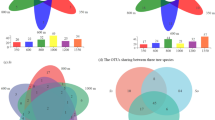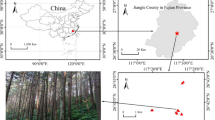Abstract
We investigated arbuscular mycorrhizal (AM) fungal communities in secondary forests and/or Chamaecyparis obtusa plantations at eight study sites in Japan’s temperate region. In the secondary forests, AM plants of the families Lauraceae, Sapindaceae, Rutaceae, Araliaceae, Rosaceae, Magnoliaceae, Cornaceae, Piperaceae, and Anacardiaceae were found. The AM fungal communities were evaluated based on compositions of the AM fungal operational taxonomic units (OTUs), which were clustered at a 97% similarity threshold of the sequences of a partial small subunit of a nuclear ribosomal RNA gene obtained from the plant roots. The compositions of AM fungal OTUs were significantly correlated with the plant family compositions and were significantly differentiated among the study sites and between the study forests. Interestingly, only 19 OTUs remained after selecting for those that had more than 1.0% of the total reads, and these 19 OTUs accounted for 86.3% of the total rarefied reads that were classified into 121 OTUs. Furthermore, three dominant OTUs constituted 48.0% of the total reads, and the most dominant OTU was found at all study sites, except at one. These results indicate that AM fungal communities are primarily constituted by limited AM fungal taxa in the forest ecosystems with diverse plant taxa in Japan’s temperate region. The results of basic local algorithm search tool (BLAST) searches against MaarjAM, a database of AM fungal sequences, also revealed that the AM fungi which were the three dominant OTUs are distributed in forest ecosystems on a worldwide scale.



Similar content being viewed by others
References
Abe S, Masaki T, Nakashizuka T (1995) Factors influencing sapling composition in canopy gaps of a temperate deciduous forest. Vegetatio 120:21–32. https://doi.org/10.1007/BF00033455
Caporaso JG, Kuczynski J, Stombaugh J, Bittinger K, Bushman FD, Costello EK, Fierer N, Gonzalez Pena A, Goodrich JK, Gordon JI, Huttley GA, Kelley ST, Knights D, Koenig JE, Ley RE, Lozupone CA, McDonald D, Muegge BD, Pirrung M, Reeder J, Sevinsky JR, Turnbaugh PJ, Walters WA, Widmann J, Yatsunenko T, Zaneveld J, Knight R (2010) QIIME allows analysis of high-throughput community sequencing data. Nat Methods 7:335–336. https://doi.org/10.1038/nmeth.f.303
Correia M, Heleno R, da Silva LP, Costa JM, Rodríguez-Echeverría S (2019) First evidence for the joint disperasal of mycorrhizal fungi and plant diaspores by birds. New Phytol 222:1054–1060. https://doi.org/10.1111/nph.15571
Davison J, Moora M, Öpik M, Adholeya A, Ainsaar L, Bâ A, Burla S, Diedhiou AG, Hiiesalu I, Jairus T, Johnson NC, Kane A, Koorem K, Kochar M, Ndiaye C, Pärtel M, Reier Ü, Saks Ü, Singh R, Vasar M, Zobel M (2015) Global assessment of arbuscular mycorrhizal fungus diversity reveals very low endemism. Science 349:970–973. https://doi.org/10.1126/science.aab1161
Dumbrell AJ, Nelson M, Helgason T, Dytham C, Fitter AH (2010) Idiosyncrasy and overdominance in the structure of natural communities of arbuscular mycorrhizal fungi: is there a role for stochastic processes?. J Ecol 98:419–428. https://doi.org/10.1111/j.1365-2745.2009.01622.x
Edgar RC (2010) Search and clustering orders of magnitude faster than BLAST. Bioinformatics 26:2460–2461. https://doi.org/10.1093/bioinformatics/btq461
Edgar RC, Haas BJ, Clemente JC, Quince C, Knight R (2011) UCHIME improves sensitivity and speed of chimera detection. Bioinformatics 27:2194–2200. https://doi.org/10.1093/bioinformatics/btr381
Felsenstein J (1985) Confidence limits on phylogenies: an approach using the bootstrap. Evolution 39:783–791. https://doi.org/10.1111/j.1558-5646.1985.tb00420.x
Hamady M, Walker JJ, Harris JK, Gold NJ, Knight R (2008) Error-correcting barcoded primers allow hundreds os samples to be pyrosequenced in multiplex. Nat Methods 5:235–237. https://doi.org/10.1038/nmeth.1184
Kiers ET, Duhamel M, Beesetty Y, Mensah JA, Franken O, Verbruggen E, Fellbaum CR, Kowalchuk GA, Hart MM, Bago A, Palmer TM, West SA, Vandenkoornhuyse P, JansaJ BH (2011) Reciprocal rewards stabilize cooperation in the mycorrhizal symbiosis. Science 333:880–882. https://doi.org/10.1126/science.1208473
Klironomos JN (2003) Variation in plant response to native and exotic arbuscular mycorrhizal fungi. Ecology 84:2292–2301. https://doi.org/10.1890/02-0413
Kumar S, Stecher G, Tamura K (2016) MEGA7: Molecular Evolutionary Genetics Analysis version 7.0 for bigger datasets. Mol Biol Evol 33:1870–1874. https://doi.org/10.1093/molbev/msw054
Kusakabe R, Taniguchi T, Goomaral A, Undarmaa J, Yamanaka N, Yamato M (2018) Arbuscular mycorrhizal fungal communities under gradients of grazing in Mongolian grasslands of different aridity. Mycorrhiza 28:621–634. https://doi.org/10.1007/s00572-018-0855-7
Maeda T, Kobayashi Y, Kameoka H, Okuma N, Takeda N, Yamaguchi K, Bino T, Shigenobu S, Kawaguchi M (2018) Evidence of non-tandemly repeated rDNAs and their intragenomic heterogeneity in Rhizophagus irregularis. Commun Biol 1:87. https://doi.org/10.1038/s42003-018-0094-7
Maherali H, Klironomos JN (2007) Influence of phylogeny on fungal community assembly and ecosystem functioning. Science 316:1746–1748. https://doi.org/10.1126/science.1143082
Masaki T, Suzuki W, Niiyama K, Iida S, Tanaka H, Nakashizuka T (1992) Community structure of a species-rich temperate forest, Ogawa Forest Reserve, central Japan. Vegetatio 98:97–111. https://doi.org/10.1007/BF00045549
Oksanen J, Blanachet FG, Friendly M, Kindt R, Legendre P, McGlinn D, Minchin PR, Hara RB, Simpson GL, Solymos P, Stevens HH, Szoecs E, Wagner H (2017) Package 'vegan' community ecology package version 2.4–4. https://cran.ism.ac.jp/web/packages/vegan/vegan.pdf
Öpik M, Vanatoa A, Vanatoa E, Moora M, Davison J, Kalwij JM, Rejer Ü, Zobel M (2010) The online database MaarjAM reveals global and ecosystemic distribution patterns in arbuscular mycorrhizal fungi (Glomeromycota). New Phytol 188:223–241. https://doi.org/10.1111/j.1469-8137.2010.03334.x
Öpik M, Davison J, Moora M, Zobel M (2013a) DNA-based detection and identification of Glomeromycota: the virtual taxonomy of environmental sequences. Botany 92:135–147. https://doi.org/10.1139/cjb-2013-0110
Öpik M, Zobel M, Cantero JJ, Davison J, Facelli JM, Hiiesalu I, Jairus T, Kalwij JM, Koorem K, Leal ME, Liira J, Metsis M, Neshataeva V, Paal J, Phosri C, Põlme S, Reier Ü, Saks Ü, Schimann H, Thiery O, Vasar M, Moora M (2013b) Global sampling of plant roots expands the described molecular diversity of arbuscular mycorrhizal fungi. Mycorrhiza 23:411–430. https://doi.org/10.1007/s00572-013-0482-2
Pringle A, Bever JD (2008) Analogous effects of arbuscular mycorrhizal fungi in the laboratory and a North Carolina field. New Phytol 180:162–175. https://doi.org/10.1111/j.1469-8137.2008.02537.x
Remy W, Taylor TN, Hass H, Kerp H (1994) Four hundred-million-year-old vesicular arbuscular mycorrhizae. Proc Natl Acad Sci 91:11841–11843. https://doi.org/10.1073/pnas.91.25.11841
Sanders IR, Alt M, Groppe K, Boller T, Wiemken A (1995) Identification of ribosomal DNA polymorphisms among and within spores of the Glomales: application to studies on the genetic diversity of arbuscular mycorrhizal fungal communities. New Phytol 130:419–427. https://doi.org/10.1111/j.1469-8137.1995.tb01836.x
Sato K, Suyama Y, Saito M, Sugawara K (2005) A new primer for discrimination of arbuscular mycorrhizal fungi with polymerase chain reaction-denature gradient gel electrophorsis. Grassl Sci 51:179–181. https://doi.org/10.1038/363067a0
Simon L, Bousquet J, Lévesque RC, Lalonde M (1993) Origin and diversification of endomycorrhizal fungi and coincidence with vascular plants. Nature 363:67–69. https://doi.org/10.1038/363067a0
Smith SE, Read DJ (2008) Mycorrhizal symbiosis, 3rd edn. Academic Press, New York
Spatafora JW, Chang Y, Benny GL, Lazarus K, Smith ME, Berbee ML, Bonito G, Corradi N, Grigoriev I, Gryganskyi A, James TY, O'Donnell K, Roberson RW, Taylor TN, Uehling J, Vilgalys R, White MM (2016) A phylum-level phylogenetic classification of zygomycete fungi based on genome-scale data. Mycologia 108:1028–1046. https://doi.org/10.3852/16-042
Tedersoo L, Bahram M, Toots M, Diédhiou AG, Henkel TW, Kjoller R, Morris MH, Nara K, Nouhra E, Peay KG, Põlme S, Ryberg M, Smith ME, Kõljalg U (2012) Towards global patterns in the diversity and community structure of ectomycorrhizal fungi. Mol Ecol 21:4160–4170. https://doi.org/10.1111/j.1365-294X.2012.05602.x
Taberlet P, Gielly L, Pautou G, Bouvet J (1991) Universal primers for amplification of three non-coding regions of chloroplast DNA. Plant Mol Biol 17:1105–1109. https://doi.org/10.1007/BF00037152
Taberlet P, Coissac E, Pompanon F, Gielly L, Miquel C, Valentini A, Vermat T, Corthier G, Brochmann C, Willerslev E (2007) Power and limitations of the chloroplast trnL (UAA) intron for plant DNA barcoding. Nucleic Acids Res 35:e14. https://doi.org/10.1093/nar/gkl938
van der Heijden MGA, Klironomos JN, Ursic M, Moutoglis P, Streitwolf-Engel R, Boller T, Wiemken A, Sanders IR (1998) Mycorrhizal fungal diversity determines plant biodiversity, ecosystem variability and productivity. Nature 396:69–72. https://doi.org/10.1038/23932
Van Geel M, Busschaert P, Honnay O, Lievens B (2014) Evaluation of six primer pairs targeting the nuclear rRNA operon for characterization of arbuscular mycorrhizal fungal (AMF) communities using 454 pyrosequencing. J Microbiol Methods 106:93–100. https://doi.org/10.1016/j.mimet.2014.08.006
Xu M, Li X, Cai X, Li X, Christie P, Zhang J (2017) Land use alters arbuscular mycorrhizal fungal communities and their potential role in carbon sequestration on the Tibetan Plateau. Sci Rep 7:3067. https://doi.org/10.1038/s41598-017-03248-0
Yamato M, Iwasaki M (2002) Morphological types of arbuscular mycorrhizal fungi in roots of understory plants in Japanese deciduous broadleaved forests. Mycorrhiza 12:291–296. https://doi.org/10.1007/s00572-002-0187-4
Yamato M, Iwase K (2005) Community analysis of arbuscular mycorrhizal fungi in a warm-temperate deciduous broad-leaved forest and introduction of the fungal community into the seedlings of indigenous woody plants. Mycoscience 46:334–342. https://doi.org/10.1007/S10267-005-0256-6
Yamato M, Takahashi H, Shimono A, Kusakabe R, Yukawa T (2016) Distribution of Petrosavia sakuraii (Petrosaviaceae), a rare mycoheterotrophic plant, may be determined by the abundance of its mycobionts. Mycorrhiza 26:417–427. https://doi.org/10.1007/s00572-016-0680-9
Acknowledgments
We would like to thank Takamichi Orihara, Ayako Shimono, and Keisuke Harada for their help with sampling. We appreciate the permission for sampling given at Hiruzen by the Field Science Center, Faculty of Agriculture in Tottori University; at Sendai by the Kyushu Electric Power Co., Inc.; at Ashigara by the Ashigara Green Service Co., Ltd.; at Manazuru by the Industrial Tourism Division in Manazuru Town; at Otsu by the Faculty of Science and Technology, Ryukoku University; at Funyu by the Utsunomiya University Forest; and at Hirakura by the Kii-Kuroshio Bio-regional Field Science Center, Mie University. The authors would also like to thank Enago (www.enago.jp) for the English language review.
Funding
This study was supported by a Grant-in-Aid for Scientific Research (16K07770) from the Ministry of Education, Culture, Sports, Science, and Technology, Japan.
Author information
Authors and Affiliations
Corresponding author
Ethics declarations
Conflict of interest
The authors declare that they have no conflict of interest.
Additional information
Publisher’s note
Springer Nature remains neutral with regard to jurisdictional claims in published maps and institutional affiliations.
Rights and permissions
About this article
Cite this article
Miyake, H., Ishitsuka, S., Taniguchi, T. et al. Communities of arbuscular mycorrhizal fungi in forest ecosystems in Japan’s temperate region may be primarily constituted by limited fungal taxa. Mycorrhiza 30, 257–268 (2020). https://doi.org/10.1007/s00572-020-00945-z
Received:
Accepted:
Published:
Issue Date:
DOI: https://doi.org/10.1007/s00572-020-00945-z




